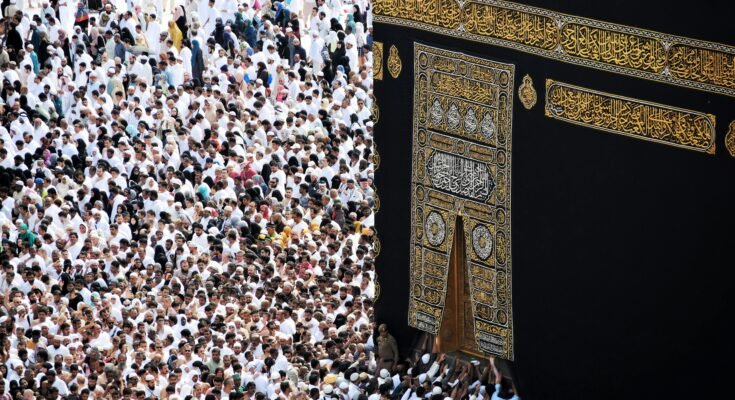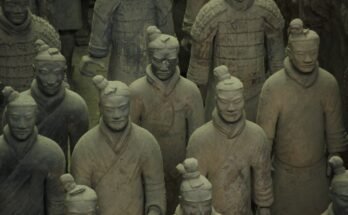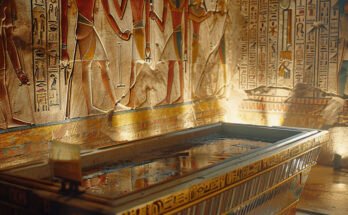Makkah is one of the world’s important cities from its historical, religious, and cultural perspectives. It is situated in modern-day Saudi Arabia. It is the birthplace of Prophet Muhammad and the hub of worship, and over 1.9 billion Muslims either devotedly visit or dream of staying for the sake of unearthly bliss. Besides religious significance, Makkah has a long and glorious history centered on trade in the Arabian Peninsula, intricately woven with spiritual and economic threads that fashioned the city through millennia.
A Sacred City and the Kaaba.
The identity of Makkah as a sacred city is inextricable from the Kaaba, that ancient and revered edifice in the heart of the Masjid al-Haram, the Grand Mosque. The Kaaba is a cube-shaped house sheathed in black cloth embroidered in gold, boasting an unequaled importance in Islam. The qibla is the direction Muslims around the world turn to during their daily prayers, signifying concentration and devotion to Allah. Its zenith in worship freezing the profound spiritual importance of the Kaaba, hence making Makkah the spiritual capital of Islam.
The genesis of Kaaba cannot be anything else but steeped in religious tradition among Muslims. According to the Quran, Kaaba was first built by Prophet Ibrahim (Abraham) together with his son Ismail (Ishmael) as a house dedicated to the worship of Allah. They were instructed by Allah to purify the structure for worshippers who would come to worship, hence, prayers, devotions, or pilgrimage. This was an act of obedience and devotion that elevated the Kaaba to being a beacon of faith long before Islam took place, linked to the previous Abrahamic traditions.
Hajj and Umrah pilgrimage rituals revolve around the Kaaba, which brings millions of Muslims from around the world each year to Makkah. Circumambulating the Kaaba seven times-a rite of devotion known as tawaf-the pilgrims express submission to Allah. An entire Muslim community represented by millions circling the Kaaba in white garments is probably the most potent symbol of equality and unity in Islam.
The spirit of the Kaaba is not merely a matter of a structure; rather, it is regarded as an axis: a transcending link connecting Muslims to each other, and time in history. The rituals performed around it strongly serve as a reminder of values of humility, obedience, and unity at the core of Islam not only making Kaaba into a landmark but also turning it into a profound symbol of faith and devotion.
Birthplace of Islam
Makkah is of unique precedence in the history of Islam regarding both the birthplace of Prophet Muhammad and of the cradle of the faith of Islam. This is where, in 570 CE, the Prophet was born into the family of the Quraysh, the venerable Arab kraal who enjoyed the privilege of housekeepers of the Kaaba, a monumental religious institution. Kicking off in his childhood in the city of Makkah that laid the foundation for the emergence of another religion-creed whose essence, propagation, possibly, was to devise the common good, so to speak, not only for Arabia but also outside it on spiritual, social, and political realms.
At the age of forty, while meditating in the Cave of Hira, on Jabal al-Nour near Makkah, Jibreel (Gabriel) brought the first verses of revelation to him. This was the beginning of the opening of the Quran and the beginning of the launching of the Prophet’s mission of recruiting adherents to a confessional faith in a God of monotheism, justice, and social change. This declaration unequivocally challenged the rank-and-file polytheistic legacy of the Makkah shrine-abode, where idols were worshipped enshrined in the Kaaba, thus rendering its perusal more revolutionary and controversial.
Rising against tremendous persecution at the hands of Quraysh leaders, the Prophet forwarded the call of Islam to a handful of followers, who remained loyal to him through thick and thin. Early Muslims suffered great tortures, boycotts, and eventually, exile. But their steadfast resolve and belief gave birth to an entirely new regime based upon spiritual values. Though since the beginning of his campaign the Prophet faced persecution by the Quraysh – his word seemed irrepressibly revolutionary, and deemed controversial. His campaign that was to reach a turning point in world history introducing the spiritual center of fleeing community to Makkah.
In 622 A.D., oppression and antagonism drove Muhammad (PBUH) and his followers from Makkah to Madinah in a historic event known as the Hijrah. It was a transition point which augured the beginning of the Islamic calendar. Makkah, however, continued, nevertheless, to be within the field of Muhammad’s mission. In 630, he led an almost bloodless conquest of Makkah in its peaceful acceptance of Islam. Idols were destroyed within the massive sacred structure, Kaaba, a speech setting up cultic worship with a purely monotheistic spirit in its most elegant genesis by Prophet Ibrahim.
Today this great historical city of Makkah still remains the birthplace of Islam, culminating in its designation as a blessed city where millions of Muslims flock to offer their prayers and take part in other spiritual activities. Great historical structures standing today like the blessed Kaaba and Jabal al-Nour remind people it all started modestly, becoming a faith revered by billions around the world.
A Hub of Ancient Trade
Long before ascending to spiritual heights, Makkah thrived as an important commercial center along the ancient trade routes of the Arabian Peninsula for this geographical position put it as an essential link with the spice and incense-producing areas of southern Arabia on one hand and with the trading centers of the Levant, Mesopotamia, and the Mediterranean on the other. Before the coming of Islam, Makkah flourished as a trade nexus due to its prime location, so long as the souqs principally fostered the movement of goods, cultures, and thoughts.
The Quraysh were, in the first place, custodians of the Kaaba whose civilization achievement put Makkah on the commercial pedestal. They supervised the trade that stretched much farther into the regions in which various commodities were available, for feeding into the trading to the rich markets of the Levant, Mesopotamia, Western Asia, and the Nile delta. The caravans did not just bring wealth to Makkah, as they also linked her with far-off civilizations and contributed to the creation of a cosmopolitan atmosphere. Because of their commitment to fairness and their tribal alliances, the Quraysh assured the security of the trade routes, which already guaranteed Makkah a dependable and well-accepted trading center.
One of the major economic activities of Makkah, even during the pre-Islamic era, was the annual season of pilgrimage. The Kaaba had already been known as a holy site, providing its services to pilgrims throughout the entire Arabian Peninsula. These pilgrims would bring goods for trade, which converted Makkah into a lively marketplace during the pilgrimage season. With the amalgamation of spiritual and commercial activities, the city was endowed with the unique combination of material richness and spiritual significance.
The trade network of Makkah was conducive to the exchange of cultural and intellectual ideas. Merchants from different continents, such as Africa, India, Persia, and Byzantium, passed through Makkah, bringing with them new ideas and technologies as well as cultural practices. Such an exposure on the part of Makkah to different influences merged with cosmopolitan identity-contributing to the early spread of Islam.
The city thrived as a major trade center due to its unique ingenuity, despite the extremely arid and inhospitable conditions of the Arabian Peninsula. Its markets like the famous Suq Ukaz were not only centers of commerce but also centers of poetry, storytelling, and diplomacy, which reflected the multifaceted role Makkah assumed within pre-Islamic Arabia.
The echoing legacy of the ancient trade of Makkah has become an integral part of the city’s subsequent spiritual era, paving the way for the latter. The ability of the city to act as a meeting point among diverse regions and cultures remains evidence of its continuous importance in history. Makkah’s erstwhile position as a melting pot of ancient trade, however, is to remind contemporary folks of a function beyond its all-encompassing character as the spiritual center of Islam engendering the development of human civilization.
Transformation in Modern Times
A major isolation of modern Makkah is manifest in the sprawling forth of the Masjid al-Haram, or the Grand Mosque. This mosque has undergone extraordinary renovation and expansion work by successive Saudi administrations over the last century and is now the largest mosque in the world. With the capacity to hold in excess of 2 million worshippers at once, it now boasts multi-level prayer areas, state-of-the-art cooling systems, and several facilities to better ensure the comfort of pilgrims within the mosque. Special care has been taken to safeguard the central shrine of the complex, the Kaaba, in the face of such modern renovations.
The skyline of the city has roughly altered from now the erecting of the Abraj Al-Bait Towers, also known as the Royal Clock Tower. This structure is one of the tallest buildings on the globe and contains luxury hotels, retail outlets, and the biggest clock face in the world, sited next to the Grand Mosque. In some respects, the Royal Clock Tower and the Abraj Al-Bait Towers are also an important part of the city’s modern development and practical services for pilgrims. To this end, the modernization of transportation infrastructure for pilgrims has assumed a central importance in developing Makkah. The city is now connected with Jeddah and Madinah by high-speed rail networks, such as the Haramain High-Speed Railway, making pilgrim travel much more efficient and organized. In addition to this, improvements to highways, airports, and public transport systems make it a lot easier for millions of road users to access the destination during pilgrimage seasons. These development pursuits meet the needs of modern-day pilgrims; at the same time, attempts have been undertaken to uphold the historical and spiritual identity of the city. The Cave of Hira, Jabal al-Nour, and Zamzam Well are some of the places that remain part of the pilgrimage, which has given the visitors a chance to appreciate the origin of Islam. However, modern urbanization has not come without its share of controversy, with some traditional neighborhoods and historic landmarks replaced with modern infrastructure, resulting in a debate about the balance between development and heritage preservation, Makkah today stands a city where its age-old heritage looks deathly merged with modernity. Here faith coexists with function, giving millions the opportunity to practice their holed spirituality amidst modern urban comforts. This metamorphosis is emblematic of an irreplaceable dynamic in the unique historical role reflected in Makkah’s luminous stature as a constant beacon of faith and modern hub of global prominence.
A City of Unity and Legacy
Makkah embodies a symbol of unity and legacy. Beyond geographical and historical borders, it has imbued life to billions of Muslims around the world. The holiest city in Islam is one that acts as a basis of spiritual bondage for Muslims and creates a feeling of brotherhood among all Muslims and upholds equality of people globally, breaking boundaries of race, nationality, and social class. This ever- enduring unity embodies the great spiritual and historical significance attached to it.
This unity has the appearance of Hajj, one of the most important Five Pillars of Islam, and forms the foundation upon which the other acts of dedication are built. Every year, millions of Muslims of diverse cultures and backgrounds come to Makkah, wearing the same simple white garments which erase the distinction between the rich and the poor, or whites and blacks. Pilgrims perform the same rites and have the same experience, reaffirming their faith in the brotherhood of the global Muslim ummah (community).
The city’s legacy is related to the life and mission of the Prophet Muhammad (PBUH). As the birthplace of Islam, Makkah has historical sites which reflect the beginning of their faith. These include the Kaaba, the Zamzam Well, and Jabal al-Nour where the first revelation of the Holy Quran descended. Such sacred places and other historic sights did not just con¬vene to tickle the travel interest, but symbolize love and resilience to Muslims who bore witness of the heroic feats and crisis of the early Islamic community.
In modern times, Makkah continues to embody that unity and legacy. This city has made an effort to keep up with the demands of present-day pilgrims; modern infrastructural tuning and technological input signal capacity for millions of pilgrims to visit each year. And while this modernity exists, Makkah shall remain steadfast in remembrance of her spiritual heritage; a beacon enlivening Islam’s message for peace, equality, and devotion to Allah in the hearts and souls of evil, as demise came upon them.
For Muslims, Makkah is not a location but rather one that stylizes their minds and beings, into faith as the clock hands lend coherence, presenting itself in terms of time as a city bridging the past, present, and future of Islam. As a symbol of unity and a keeper of a long tradition, Makkah continues to inspire and unite the hearts of all believers around the globe.



